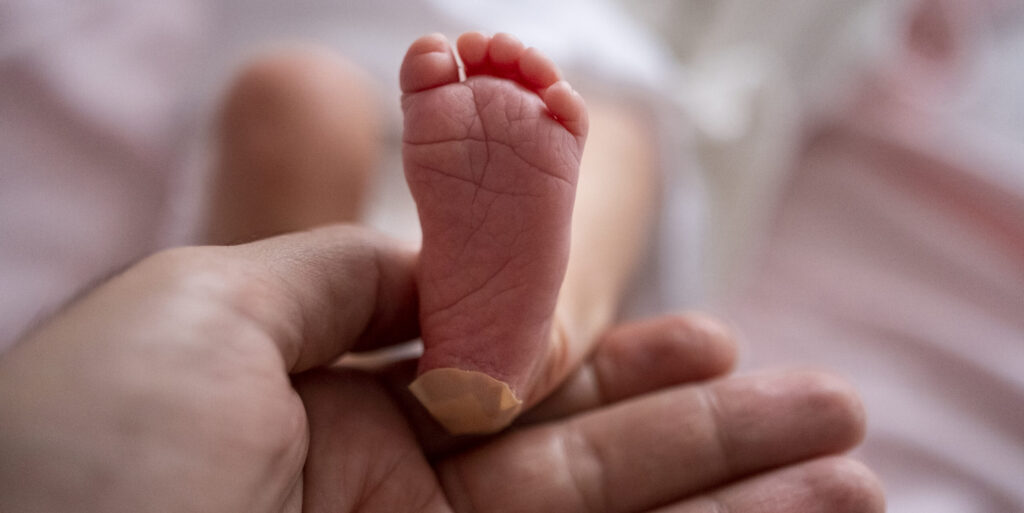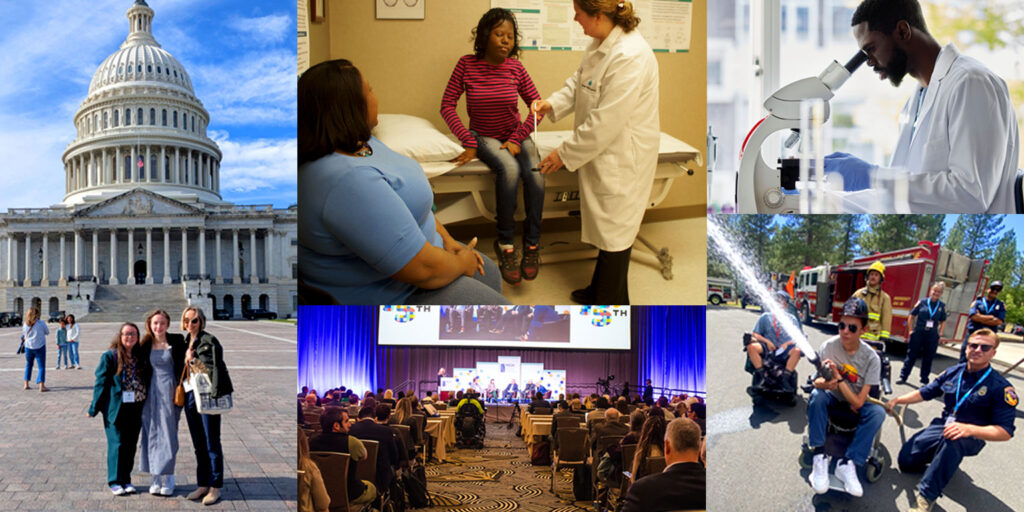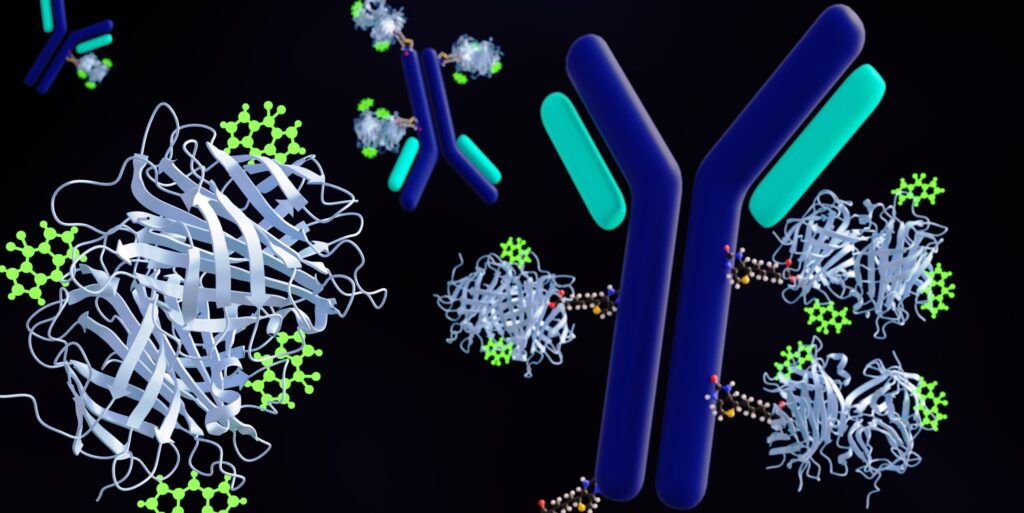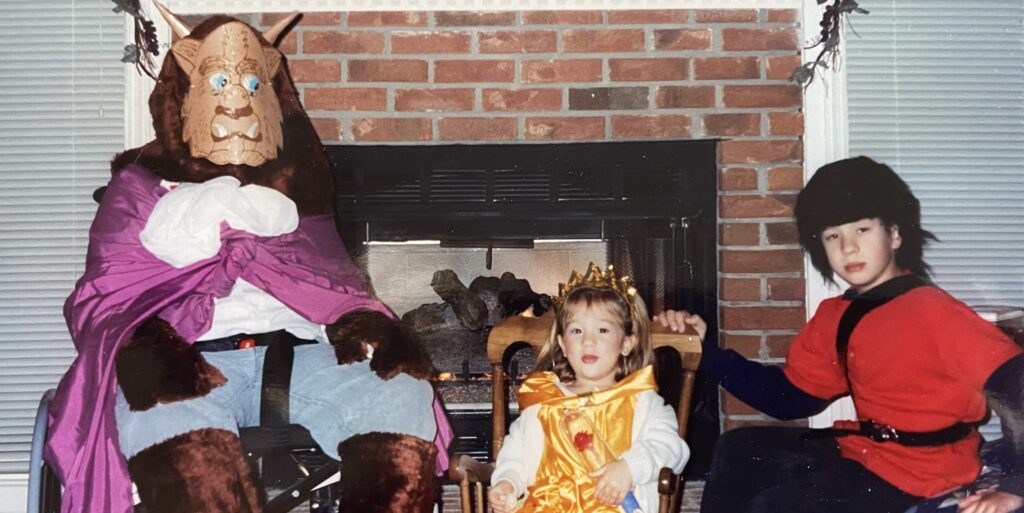
MDA Ambassador Guest Blog: Helpful Tips for Accessible Halloween Costumes
By Megan Jennings | Wednesday, October 1, 2025
Megan Jennings, known professionally as Sybil Thorn, is an artist and freelance creator. Born with spinal muscular atrophy, she received her bachelor’s degree in Theater and English with an emphasis in Creative Writing from Presbyterian College, where one of her favorite classes was in costume design. As a lifelong costumer, she looks forward to Halloween every year.
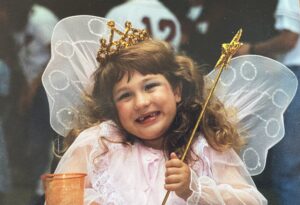
Megan dressed as a fairy.
When I was growing up, Halloween was never just about candy – it was about imagination. In my family, we made our costumes from scratch. Some years that meant raiding the craft bin and recycling boxes; other years it meant hot glue gun burns and glitter everywhere. My eldest brother and I both have spinal muscular atrophy (SMA) and have used wheelchairs for most of our lives, but that has never stopped us from creating incredible and creative Halloween costumes. In fact, it added a whole new dimension to the art of costume-making. We didn’t just dress up as characters—we built worlds around us. One year, the chair became a train; another year, a bobsled; and sometimes it was just there in the background while we went all in on masks and capes.
Halloween quickly became my favorite holiday. It’s the one time of year when kids get to decide exactly who they want to be—no limits, no rules. Want to be a pirate? A robot? A superhero? Done. All it takes is creativity and commitment. For children with disabilities, I believe this lesson is even more crucial. Halloween is the perfect opportunity to show them that their identity is not defined by what they can’t do, but by how far their imagination and determination can take them.
Step One: Brainstorm together
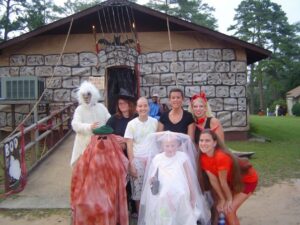
Megan, with friends, dressed as “Cousin It”.
The process of designing a costume starts with a conversation. Ask your child what they’d love to be for Halloween. Don’t hold back—no idea is too wild at this stage. During this step, it’s important to talk about whether or not they’d like to incorporate their equipment (such as a wheelchair, walker, or crutches) into the design of their costume. Some kids love the chance to turn a chair into a race car, rocket ship, or even a dragon. For those who use crutches, canes, or walkers, there are equally creative ways to turn these into interesting costume accessories as well. For instance, with the addition of a spray-painted empty paper towel roll and some glow-in-the-dark gaffer tape (which is designed for easy removal without residue), a cane can be turned into a relatively excellent lightsaber. Others may prefer a costume that doesn’t highlight the equipment at all. Both choices are completely valid. What matters is that your child feels a sense of ownership over their costume. At this stage, it might be helpful to have your child sketch what they are imagining. This might be done by your child, either with their favorite art supplies or digitally, or you and your child could create the sketch together, with them describing to you how to draw what they want.
Step Two: Hunt for supplies
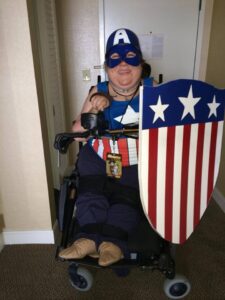
Megan dressed as Captain America.
Once you’ve got the idea nailed down and sketched out, it’s time to track down materials. This is where creativity truly shines. Costumes don’t need to come from expensive specialty stores—they can be built out of cardboard, paint, fabric scraps, old clothes, thrift store finds, and even kitchen supplies. The trick is to see possibilities where others might see junk. A shower curtain can become a superhero cape. A cardboard box can be transformed into a treasure chest or a spaceship. Foam sheets and duct tape can be made into armor. The best costumes are often the ones made with a bit of ingenuity and a lot of heart. You can then use the sketch created during brainstorming to compile a list of all the items you will need to make the costume a reality. This is an excellent opportunity for your child to think of creative solutions. Children are incredibly imaginative, and I’m sure you’ll be surprised by how readily your child can think of things that can be used for their costume.
Step Three: Get crafting
Costumes can be made with very inexpensive materials and can be made fairly easily in a short amount of time if necessary. Cardboard, Styrofoam, spray paint, felt, crafting foam, hair clips, Velcro, hot glue, gaffer tape, and duct tape can be your best friends when crafting a costume. Vintage stores, discount stores, and bargain bins are great resources for costuming supplies. Hand-me-down items can also make for excellent costuming supplies.
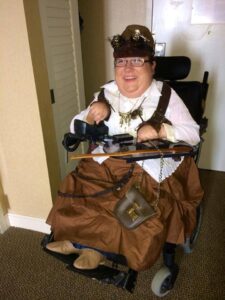
Megan in her “Steampunk” costume.
From creating a go-go dancer costume with supplies found solely at discount stores and in bargain bins to designing a steampunk costume around a vintage purse handed down to me by my mother, I find that part of the fun is in the hunt for the materials you will need for your costume. One year. I created a costume as a train conductor. My power wheelchair served as the engine of the train with two train cars made from my old manual wheelchairs tethered behind it. I sourced cardboard boxes used to create the train costume by asking local grocery stores for their empty boxes after they restocked their shelves.
Another time, I dressed as Cousin It from the Adams Family. I made this costume at MDA Camp from a simple piece of white fabric that had been spray-painted. My Captain America costume was built using a Styrofoam shield and spray-painting a costume army helmet and plastic mask. My brother, Ryan, crafted an impressive Mr. Potato Head costume using felt material, Velcro, hot glue, and Styrofoam.
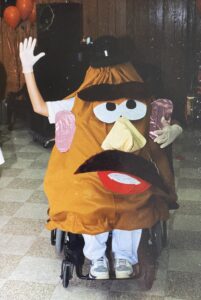
Ryan, Megan’s brother, in a “Mr. Potato Head” costume he created.
Costumes don’t have to be extravagant to still be awesome. Sometimes, a little makeup or a simple mask can go a long way. And sometimes you can create a complete costume using items you already have on hand. One year to answer the door for Halloween, I dressed up as a fortune teller using only items I found in my own closet.
If you don’t have time to craft a full costume, smart shopping can help you provide the perfect costume for the occasion. Custom costume pieces can be found online from artisans, and often, simple costume accessories can be excellent finds in retail stores. The day after Halloween, stores usually offer extreme discounts on their costuming supplies, making it a good idea to stock up for next year.
Other options
Of course, these days, not everyone has the ability to take on a crafting project like making their kid’s Halloween costume with them. For children without disabilities, there is an easy solution for this, as many major retail stores sell Halloween costumes for kids. But when you have a disability, it can often be challenging to find a Halloween costume that works for you, given that pre-made costumes are often not very accessible to wear. Perhaps you are the parent of a child with a disability and you are interested in helping them have an amazing costuming experience for Halloween, but lack the time and resources to create a costume with them. In that case, you may also consider commissioning costume pieces from freelance artisans and crafters. As someone who has done this myself through Etsy, I can recommend doing so. I suggest finding an artist who is willing to work closely with you during the process and such an endeavor should be done well ahead of the Halloween season.
Additionally, there are several philanthropic organizations dedicated to making Halloween more magical for children with disabilities by designing custom costumes that cater to their specific needs. Groups like Magic Wheelchair and Walkin’ & Rollin’ Costumes work with volunteers to transform wheelchairs, walkers, and other accessible equipment into incredible creations—think pirate ships, race cars, superheroes, and princess carriages. These costumes go beyond dress-up; they give kids a chance to shine, feel included, and experience the same joy of imagination as their peers, while also reminding families that they’re part of a larger community of support and creativity.

Reveals with previous sweepstakes winners from the Muscular Dystrophy Association and Magic Wheelchair collaboration. L to R: Carter as a Ghostbuster; Katherine as Velma in her Scooby Doo Mystery Machine; Mason hard at work in his dream dinosaur digger truck.
In fact, the Muscular Dystrophy Association has continued collaborations with Magic Wheelchair each Halloween with an annual sweepstakes that provides one winner from the neuromuscular community with a custom-made, accessible, and dream costume. This year’s contest will run October 27 – 29 on Instagram and the winner of the sweepstakes will receive a costume reveal in 2026 (enter the sweepstakes by following @MDAorg and @MagicWheelchair on Instagram and commenting on daily collaborative posts with a purple heart emoji. Read the rules of engagement here).
Why it matters
Halloween is more than dress-up. It’s about empowerment. When kids learn that they can create something magical out of everyday items, they start to believe they can shape the world around them, too. For children with disabilities, this lesson is golden. It reminds them that their disability doesn’t have to be a limitation and that imagination has no boundaries. For me, those nights spent crafting with my family taught me not just to love Halloween, but to love creativity itself. And now, whenever I see kids with gleaming eyes showing off their homemade or customized costumes, I know they’re learning the same thing: they can be whoever they want to be. That is a lesson that even us adults should be reminded of regularly, which is why, in my opinion, costuming isn’t just for kids. For me, it’s a lifelong creative outlet.
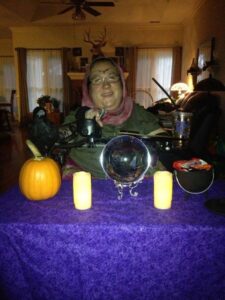
Megan as a “Fortune Teller”.
As an adult, I still throw myself into creating costumes with the same enthusiasm I had growing up. I’ve dipped into cosplay, building characters piece by piece, and I’ve even been fortunate enough to have had some experience in theatrical costume design. Additionally, a few years ago, I decided to create a “forever” Halloween costume that I could add to or alter a little every year. Most of it, except a few pieces that I ordered custom-made, has been crafted little by little at home from upcycled materials and bargain craft supplies I’ve picked up over time, which makes it even more rewarding. For me, it’s proof that costuming isn’t about age – it’s about imagination, resourcefulness, and the joy of bringing an idea to life. So this Halloween, I encourage you to embrace costuming!
Next Steps and Useful Resources
- Follow both @MDAorg and @MagicWheelchair on Instagram for a chance to win the 2025 Muscular Dystrophy Association and Magic Wheelchair Sweepstakes for a dream costume reveal in 2026! Sweepstakes rules here.
- Additional information and resources about DIY wheelchair costumes are also available here.
TAGS: Ambassador Guest Blog, Ambassadors, Community, Relationships, Young Adults
TYPE: Blog Post
Disclaimer: No content on this site should ever be used as a substitute for direct medical advice from your doctor or other qualified clinician.


